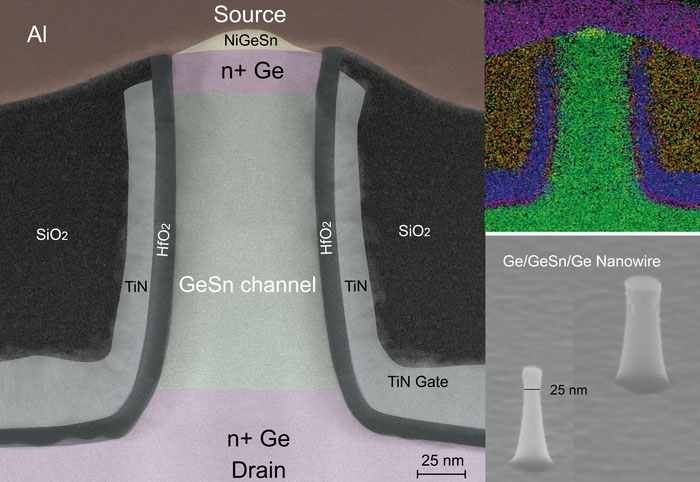
New germanium-tin transistor as an alternative to silicon
[ad_1]
(Nanowerk News) Over the past 70 years, the number of transistors on a chip has doubled roughly every two years – according to Moore’s Law, which still holds true today. The circuits got smaller, but the end of this development seemed in sight.
“We have now reached the stage where the structures are only 2 to 3 nanometers in size. This is roughly the diameter of 10 atoms, which brings us to a reasonable limit. It doesn’t get any smaller than this,” said Qing-Tai Zhao of the Peter Grünberg Institute (PGI-9) in Forschungszentrum Jülich.
For some time now, researchers have been looking for a substitute for silicon, the main material used in the semiconductor industry.
“The idea was to find a material that has more favorable electronic properties and can be used to achieve the same performance with larger structures,” explains the professor.
This research focused in part on germanium, which was already in use at the start of the computer age. Electrons can move faster in germanium than in silicon, at least in theory. However, Qing-Tai Zhao and company had now gone a step further. To optimize the electronic properties even further, they introduced tin atoms into the germanium crystal lattice. This method was developed several years ago at the Peter Grünberg Institute (PGI-9) in Forschungszentrum Jülich.
The research has been published in Communication Engineering (“Vertical GeSn nanowire MOSFETs for CMOS beyond silicon”). “The germanium–tin system we have tested makes it possible to overcome the physical limitations of silicon technology,” said Qing-Tai Zhao. In experiments, germanium-tin transistors exhibited electron mobility 2.5 times higher than comparable transistors made of pure germanium.

Another advantage of this new material alloy is that it is compatible with existing CMOS processes for chip manufacturing. Germanium and tin come from the same main group in the periodic table as silicon. Therefore, germanium-tin transistors can be integrated directly into conventional silicon chips with existing production lines. High potential for future computers
In addition to classical digital computers, quantum computers can also utilize germanium-tin transistors. For some time, there have been attempts to integrate control electronic parts directly on quantum chips, which operate inside quantum computers at temperatures close to absolute zero. Measurements show that a transistor made of germanium-tin will perform much better under these conditions than one made of silicon.
“The challenge was to find a semiconductor whose switching can still be very fast with low voltages at very low temperatures,” explained Qing-Tai Zhao. For silicon, this transition curve flattens below 50 Kelvin. Then, the transistor requires high voltage and thus high power, which eventually leads to failure of the sensitive quantum bit due to heating. “Tin germanium performs better at these temperatures in measurements down to 12 Kelvin, and there is hope for using the material at even lower temperatures,” said Qing-Tai Zhao.
In addition, the germanium-tin transistor is a further step towards optical on-chip data transmission. Transmission of information by light signals has become the standard in many data networks because it is much faster and more energy efficient than the transfer of data across electrical conductors. However, in the field of micro- and nanoelectronics, data is usually still transmitted electrically.
Colleagues from the Jülich working group Dr. Dan Buca has developed a germanium-tin laser in the past which opens up the possibility of transmitting data optically directly on silicon chips (Nature Photonics, “Ultra-low-threshold continuous-wave and pulsed lasing in tensile stress GeSn alloy”). The germanium-tin transistor, along with these lasers, provide a promising solution for the monolithic integration of nanoelectronics and photonics on a single chip.
[ad_2]
Source link




